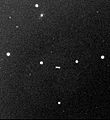Callirrhoe (moon) facts for kids
Callirrhoe or Jupiter XVII is one of Jupiter's farthest named moons. It's like a tiny natural satellite orbiting the giant planet.
Contents
Discovery of Callirrhoe
Callirrhoe was first spotted by a project called Spacewatch on October 6, 1999. At first, scientists thought it was just another asteroid floating in space. But then, on July 18, 2000, Tim Spahr discovered that it was actually orbiting Jupiter! After this, it was given a special temporary name: S/1999 J 1.
About Callirrhoe
Callirrhoe is quite small, only about 8.6 kilometers (about 5.3 miles) wide. It travels around Jupiter at a very long distance, averaging 24,356,000 kilometers (about 15 million miles). One full trip around Jupiter takes Callirrhoe about 776.5 days, which is more than two Earth years!
Its path around Jupiter is also quite tilted. This tilt, called an inclination, is about 141 degrees compared to the ecliptic (the path the Sun seems to take across the sky). Its orbit is also not a perfect circle; it's a bit stretched out, which scientists call an orbital eccentricity of 0.264.
How Callirrhoe Got Its Name
In October 2002, this moon was officially named Callirrhoe. The name comes from Callirhoe, a character in ancient Greek myths. She was the daughter of the river god Achelous. In mythology, Callirhoe was one of the many people connected to Zeus, who is the Greek equivalent of the Roman god Jupiter.
Part of the Pasiphaë Group
Callirrhoe belongs to a group of moons called the Pasiphaë group. These moons are special because they are not perfectly round, and they orbit Jupiter "backwards" compared to Jupiter's spin. This is called a retrograde orbit.
The moons in the Pasiphaë group orbit Jupiter at distances between 22,800,000 and 24,100,000 kilometers. Their orbits are also quite tilted, ranging from 144.5 to 158.3 degrees.
Callirrhoe and New Horizons
On January 10, 2007, the New Horizons spacecraft took pictures of Callirrhoe. This was done as a practice exercise to help the spacecraft's navigation system work perfectly for its main mission to Pluto.
Images for kids
-
This image shows Callirrhoe moving against the background stars. It was made by combining three pictures taken by the VLT in July 2000.
See also
 In Spanish: Calírroe (satélite) para niños
In Spanish: Calírroe (satélite) para niños



